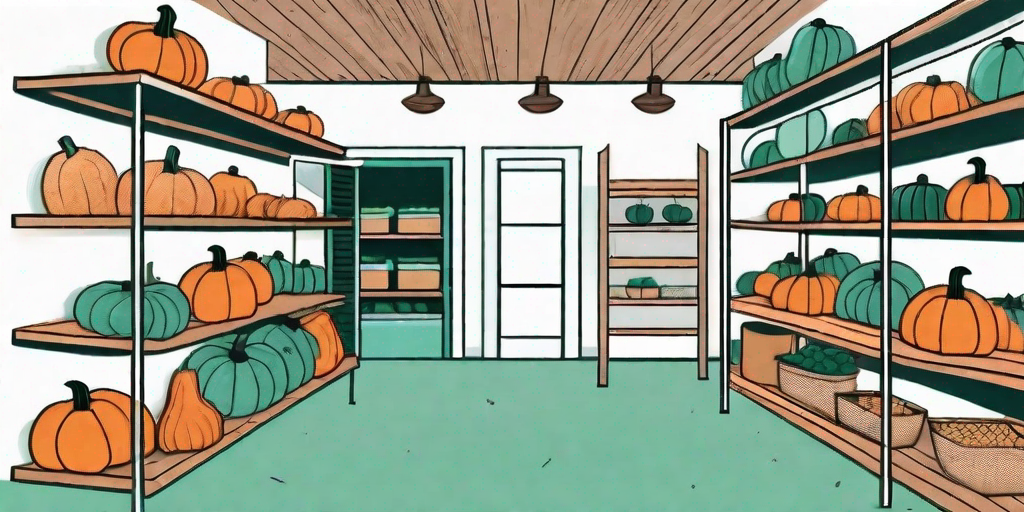
Ah, the humble pumpkin. A symbol of autumn, a staple of Halloween, and the star of many a pie. But let's face it, when it comes to storing these orange orbs of joy, we're often left scratching our heads. Fear not, dear reader, for this guide will transform you from a pumpkin storing novice to a veritable gourd guru.
The Pumpkin Basics
Before we dive into the nitty-gritty of pumpkin storage, let's get acquainted with our subject. Pumpkins, like all squash, are members of the Cucurbitaceae family. They're native to North America and have been cultivated for thousands of years. Pumpkins are not just for carving; they're also packed with nutrients like vitamin A, potassium, and fiber.
Now, onto the most important question: how long can a pumpkin last? The answer depends on a few factors, including the type of pumpkin, its size, and how it's stored. A small, uncarved pumpkin can last several weeks, while a carved pumpkin might only last a few days. But with the right storage techniques, you can extend the life of your pumpkins and enjoy them for months.
Types of Pumpkins
There are hundreds of varieties of pumpkins, ranging from the tiny 'Jack Be Little' to the gargantuan 'Atlantic Giant'. For storage purposes, it's important to know that pumpkins can be divided into two main categories: carving pumpkins and pie pumpkins.
Carving pumpkins, also known as Jack-o'-lantern pumpkins, are large, round, and have a thick, hard shell. They're perfect for carving into spooky faces, but their flesh is often stringy and less flavorful. Pie pumpkins, on the other hand, are smaller and sweeter, with a softer shell. They're ideal for cooking and baking, but not as durable for long-term storage.
Storing Unopened Pumpkins
So, you've picked out the perfect pumpkin, and you're not quite ready to carve it or cook it. How do you keep it fresh? The key is to control the pumpkin's environment.
Pumpkins prefer cool, dry, and dark conditions. A basement, garage, or cellar is ideal, but a cool, dark corner of your kitchen will also do. Avoid places with high humidity or drastic temperature changes, as these can cause the pumpkin to rot.
Temperature Matters
The ideal storage temperature for pumpkins is between 50 and 55 degrees Fahrenheit (10-13 degrees Celsius). Any colder, and the pumpkin can freeze and become mushy when thawed. Any warmer, and the pumpkin can start to rot.
If you don't have a space that stays consistently within this temperature range, don't despair. A pumpkin can still last several weeks in less-than-ideal conditions. Just be sure to check on it regularly for signs of decay, such as soft spots or mold.
Proper Positioning
Believe it or not, how you position your pumpkin can also affect its longevity. Pumpkins should be stored on their side, not on their stem. This helps prevent moisture from collecting at the base of the stem, which can lead to rot.
Also, try to avoid stacking pumpkins on top of each other. This can cause pressure points, leading to bruising and premature rotting. If you must stack your pumpkins, use a soft cloth or piece of cardboard between each one to reduce pressure.
Storing Opened Pumpkins
Once a pumpkin has been cut open, its shelf life decreases dramatically. But don't toss that Jack-o'-lantern just yet! There are still ways to prolong its life.
Refrigeration is Key
Once a pumpkin has been carved or cut into, it should be stored in the refrigerator. This slows down the decay process and can help the pumpkin last up to a week.
If you don't have room in your fridge for a whole pumpkin, consider cutting it into smaller pieces and storing them in airtight containers. Just be sure to use the pumpkin within a few days, as cut pumpkin can quickly become slimy and moldy.
Preservation Techniques
If you're not ready to use your cut pumpkin right away, there are a few preservation techniques you can try. One popular method is to freeze the pumpkin. Simply remove the seeds and pulp, cut the pumpkin into chunks, and freeze on a baking sheet. Once frozen, transfer the chunks to a freezer bag or container. Frozen pumpkin can last up to a year.
Another option is to cook the pumpkin and then freeze or can the puree. This is a great way to have ready-to-use pumpkin on hand for pies, soups, and other recipes.
FAQs
- Can I store my pumpkin outside?
- While pumpkins can tolerate cool outdoor temperatures, they're susceptible to frost and freezing. If you must store your pumpkin outside, be sure to bring it in if temperatures are expected to drop below freezing.
- What if my pumpkin starts to rot?
- If your pumpkin starts to show signs of decay, it's best to compost it. Rotting pumpkins can attract pests and can quickly become a smelly mess.
- Can I eat a pumpkin that's been carved?
- It's generally not recommended to eat a pumpkin that's been carved and left out, especially if it's been sitting out for several days. Bacteria can quickly multiply on cut surfaces, making the pumpkin unsafe to eat.
Conclusion
With these tips and tricks, you'll be a pumpkin preservation pro in no time. So go ahead, buy that extra pumpkin at the farmer's market. With the right storage techniques, you can enjoy pumpkin season long after the leaves have fallen.
Remember, the key to pumpkin storage is controlling the environment. Keep your pumpkins cool, dry, and in the dark for maximum freshness. And when in doubt, remember the pumpkin's motto: "I'm not just for Halloween, I'm for life!"











